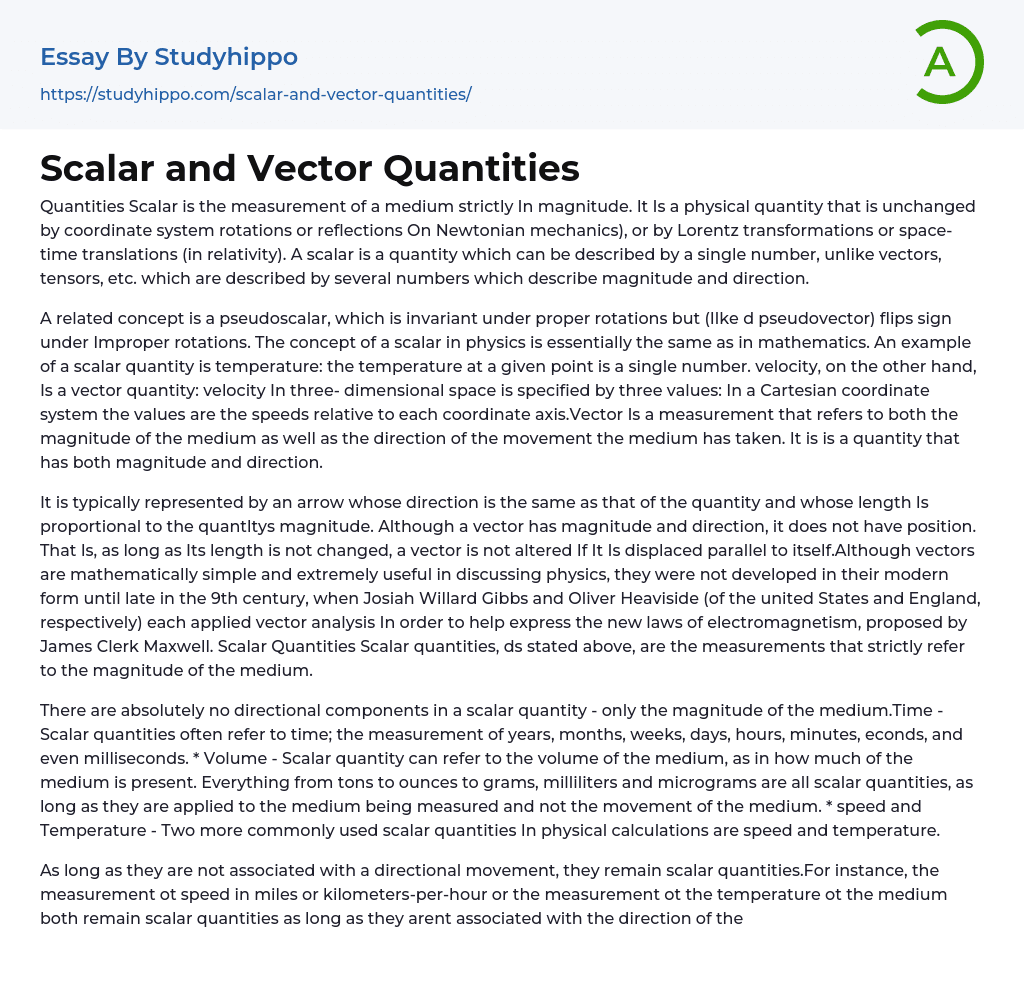Quantities Scalar is the measurement of a medium strictly In magnitude. It Is a physical quantity that is unchanged by coordinate system rotations or reflections On Newtonian mechanics), or by Lorentz transformations or space-time translations (in relativity). A scalar is a quantity which can be described by a single number, unlike vectors, tensors, etc. which are described by several numbers which describe magnitude and direction.
A related concept is a pseudoscalar, which is invariant under proper rotations but (Ilke d pseudovector) flips sign under Improper rotations. The concept of a scalar in physics is essentially the same as in mathematics. An example of a scalar quantity is temperature: the temperature at a given point is a single number. velocity, on the other hand, Is a vector quantity: velocity In three- dimensional spac
...e is specified by three values: In a Cartesian coordinate system the values are the speeds relative to each coordinate axis.Vector Is a measurement that refers to both the magnitude of the medium as well as the direction of the movement the medium has taken. It is is a quantity that has both magnitude and direction.
It is typically represented by an arrow whose direction is the same as that of the quantity and whose length Is proportional to the quantltys magnitude. Although a vector has magnitude and direction, it does not have position. That Is, as long as Its length is not changed, a vector is not altered If It Is displaced parallel to itself.Although vectors are mathematically simple and extremely useful in discussing physics, they were not developed in their modern form until late in the 9th century, when Josiah Willard Gibbs an
Oliver Heaviside (of the united States and England, respectively) each applied vector analysis In order to help express the new laws of electromagnetism, proposed by James Clerk Maxwell. Scalar Quantities Scalar quantities, ds stated above, are the measurements that strictly refer to the magnitude of the medium.
There are absolutely no directional components in a scalar quantity - only the magnitude of the medium.Time - Scalar quantities often refer to time; the measurement of years, months, weeks, days, hours, minutes, econds, and even milliseconds. * Volume - Scalar quantity can refer to the volume of the medium, as in how much of the medium is present. Everything from tons to ounces to grams, milliliters and micrograms are all scalar quantities, as long as they are applied to the medium being measured and not the movement of the medium. * speed and Temperature - Two more commonly used scalar quantities In physical calculations are speed and temperature.
As long as they are not associated with a directional movement, they remain scalar quantities.For instance, the measurement ot speed in miles or kilometers-per-hour or the measurement ot the temperature ot the medium both remain scalar quantities as long as they arent associated with the direction of the medium's travel. Vector quantities, however, refer to both the direction of the medium's movement as well as the measurement of the scalar quantity. * Increase/Decrease in Temperature - The measurement of the medium's temperature is a scalar quantity; the measurement of the increase or decrease in the medium's temperature is a vector quantity.Velocity - The measurement of the rate at which an object changes position is a vector quantity. For example:
If a person quickly moves one step forward and then one step backward there would certainly be a lot of activity; but, there would be "zero velocity.
" In order to measure the vector quantity of the medium, there must be: * A directional measurement applied to the scalar quantity. For example: Regardless of how fast an object is going, the direction of the movement must be described in the velocity vector such as "rightwards" or "forward.A beginning reference point for the directional measurement in order to provide the directional element of the vector quantity. Your beginning point could be centered in a north, south, east and west quadrant so that the vector quantity can be applied to the medium's movement. For example: To describe a car's velocity you would have to state it as 70 miles per hour, south.
Another directional element that may be applied to the vector quantity is the different between vertical and horizontal movements.
- Derivative essays
- Integral essays
- Cycle essays
- Shape essays
- Melting essays
- Algebra essays
- Arithmetic essays
- Correlation essays
- Geometry essays
- Measurement essays
- Price Elasticity Of Demand essays
- Regression Analysis essays
- Statistics essays
- Atom essays
- Big Bang Theory essays
- Density essays
- Electricity essays
- Energy essays
- Force essays
- Heat essays
- Light essays
- Motion essays
- Nuclear Power essays
- Physiology essays
- Sound essays
- Speed essays
- Temperature essays
- Thermodynamics essays




